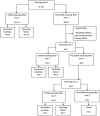Predictors of weaning failure in case of VA ECMO implantation
- PMID: 35974037
- PMCID: PMC9381562
- DOI: 10.1038/s41598-022-18105-y
Predictors of weaning failure in case of VA ECMO implantation
Abstract
The use of veno-arterial extracorporeal membrane oxygenation (VA ECMO) for the treatment of refractory cardiogenic shock has increased significantly. Nevertheless, early weaning may be advisable to reduce the potential for severe complications. Only a few studies focusing on ECMO weaning predictors are currently available. Our objective was to evaluate factors that may help predict failure during VA ECMO weaning. We included 57 patients on VA ECMO support previously considered suitable for weaning based on specific criteria. Clinical, haemato-chemical and echocardiographic assessment was considered before and after a "weaning test" (ECMO flow < 2 L/min for at least 60 min). ECMO removal was left to the discretion of the medical team blinded to the results. Weaning failure was defined as a patient who died or required a new VA ECMO, heart transplant or LVAD 30 days after ECMO removal. Thirty-six patients (63.2%) were successfully weaned off VA ECMO, of whom 31 (54.4%) after the first weaning test. In case of first test failure, 3 out of 7 patients could be weaned after a 2nd test and 3 out of 4 patients after a 3rd test. Pre-existing ischemic heart disease (OR 9.6 [1.1-83]), pre-test left ventricular ejection fraction (LVEF) ≤ 25% and/or post-test LVEF ≤ 40% (OR 11 [0.98-115]), post-test systolic blood pressure ≤ 120 mmHg (OR 33 [3-385]), or length of ECMO support > 7 days (OR 24 [2-269]) were predictors of weaning failure. The VA ECMO weaning test failed in less than 40% of patients considered suitable for weaning. Clinical and echocardiographic criteria, which are easily accessible by a non-expert intensivist, may help increase the probability of successful weaning.
© 2022. The Author(s).
Conflict of interest statement
The authors declare no competing interests.
Figures



References
-
- Rastan AJ, Dege A, Mohr M, Doll N, Falk V, Walther T, et al. Early and late outcomes of 517 consecutive adult patients treated with extracorporeal membrane oxygenation for refractory postcardiotomy cardiogenic shock. J. Thorac. Cardiovasc. Surg. 2010;139(2):302–311.e1. doi: 10.1016/j.jtcvs.2009.10.043. - DOI - PubMed
MeSH terms
LinkOut - more resources
Full Text Sources
Medical

